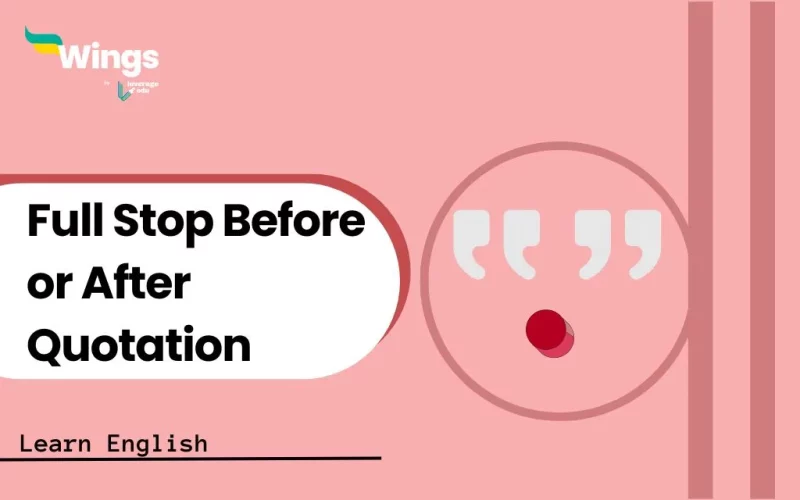In English grammar, quotation marks are used to indicate the beginning and end of a word or phrase. If the quoted material is just a word or phrase, the full stop goes outside the closing quotation mark. For example: He said, “I am happy.” She loves the word “sunshine.” Moreover, these marks can be used as double (“…”) or single (‘…’), depending on the style you use.” In this blog post, students will be able to understand how to use full stop before or after quotation.
This Blog Includes:
Also read: Punctuation Archives
How to Decide Whether to Place Full Stop Before or After Quotation?
Deciding where to put the full stop (period) with quotations depends on whether the quoted material is a complete sentence or not. If the quoted material is a complete sentence that can stand on its own, then a full stop goes before (i.e. inside) quotation marks. However, if the quoted material is a phrase or clause that depends on the main sentence for meaning, the period punctuation mark goes after (i.e. outside) the quotation marks
In the American writing style, the period punctuation generally goes inside the quotation marks, even if it ends the sentence containing the quotation. Whereas, in British style, the full stop goes outside the quotation marks if it ends the sentence containing the quotation.
Also read: Punctuation for Class 2: Types, Examples, and Worksheets
11+ Examples of Full Stop Before or After Quotation Marks
Here are some examples that can be referred to while deciding whether to put a full stop before or after quotation marks:
| Full stop before quotation marks | Full stop after quotation marks |
| 1. He declared, “I’m finished!” 2. The fortune cookie read, “Patience is a virtue. 3. “The warning label stated, “Do not operate heavy machinery while drowsy.” 4. “Where are they going?” he asked. 5. Her favourite quote is, “The only way to do great work is to love what you do.” 6. He said, “I’ll see you tomorrow.” 7. “I can’t believe it,” she exclaimed.”It’s been a long day,” he sighed. 8. “Don’t forget,” she reminded her, “to bring your umbrella.” 9.”I’m not sure,” he replied, “if I can make it.” | 1. His answer was a simple “No”. 2. Is “procrastination” your middle name? 3. Yelling “Fire!” in a crowded theatre is a crime. 4. The article ended with a profound question: “What does it mean to truly live?”. 5. He asked, “Where are you going?”. |
Exercise
How can you Indicate Quotation Marks When Speaking?
When a person is speaking, the quotation marks are indicated by using our voice to show that we’re saying another person’s words. For example, if I say, “He said, ‘I love cats,'” I might raise my voice a bit for the words “I love cats” to indicate that those are the words someone else said. So, it is like giving more stress to those words to let listeners know they are not mine.
More related blogs
FAQ’s
Ans: The last period or comma belongs inside the quotation marks, even if it is not a part of the quoted material unless the quotation is followed by a citation. And if a citation in parentheses follows the quotation, the period follows the citation.
Ans: Generally speaking, commas and full stops are only used in quotation marks if the quote is a complete sentence or if they’re part of the original quote.
Ans: Full stops are utilised to end a sentence when that sentence has expressed a complete thought or idea. They are only used to end sentences which are statements, not questions or exclamations.
In English, the correct punctuation after a quote typically includes placing periods and commas inside the quotation marks. For example: “This is a quote.” or “This is a quote,” he said.
Generally, a full stop is not necessary at the end of a caption, especially if the caption is a short phrase or incomplete sentence. However, it can be used for complete sentences.
This was all about the full stop before or after quotation in Learn English. Hope you understand the concept and know how to proceed. You can also follow the page of Leverage Edu for more exciting and informative blogs.
 One app for all your study abroad needs
One app for all your study abroad needs















 45,000+ students realised their study abroad dream with us. Take the first step today.
45,000+ students realised their study abroad dream with us. Take the first step today.
